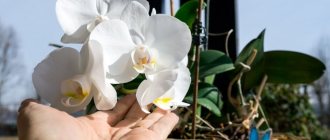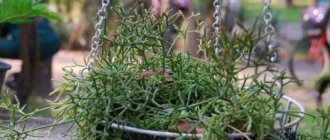Description of indoor chrysanthemum
Chrysanthemums are grown not only in the flowerbed, but also in the room. Flowers grow on the balcony, windowsill. The domestic one is usually miniature, from 15 to 70 cm.
Its shoots are smooth and meet with pile. The inflorescence is a basket of petals. The diameter of the buds is 2.5-5 cm. It blooms in August and blooms until late autumn. The leaves are arranged alternately, differ in size and shape: jagged, notched, dissected, light green in color. The rhizome is branched and develops parallel to the ground.
The bush chrysanthemum in a pot is popular among flower growers; there are species with single petals, reminiscent of daisies, and flowers like a ball. For hanging cultivation there are chrysanthemums in the form of a cascade.
Korean, Indian, and Chinese varieties are common. The color of the flowers is white, orange, lilac, pink. The color in the middle is different from the petals at the edges.
When purchasing in a store, pay attention to the presence of stains, damage, and inclusions. Such a flower should not be taken, just like one that has blossomed. Its leaves should be green, the roots should be strong, the bush should be formed.
A little history
Chrysanthemums are herbaceous annual and perennial plants belonging to the Asteraceae family, which includes 29 species. For thousands of years, they have grown in temperate and cool climates, usually in Asia.
In Europe, plants began to be cultivated in the 17th century. The chrysanthemum is considered a symbol of the imperial family in Japan. In China, the plant is considered medicinal; drugs are made on its basis for the treatment of gastrointestinal tract, eye ailments, migraines, and nervous diseases. The room also becomes more comfortable if there is a homemade chrysanthemum in a pot. How to care for it so that the flower actively develops? It is required to follow simple rules, which will be discussed below.
Classification of chrysanthemums
Plants are classified as follows:
- Sizes: large-flowered and small-flowered (less than 80 cm).
- According to the shape of the inflorescences: double, blanket, non-double, double-row, pinnate, bristly, anemoid.
- Flowering dates: early, mid, late flowering.
- Stem height: tall (45-60), medium (30-45 cm), short (15-30 cm).
- Flower shape: chamomile, spherical.
Reasons for lack of flowering
In the autumn, chrysanthemums bloom and delight with their aroma, as if giving a small piece of summer in winter. But it may also happen that the chrysanthemum does not bloom, although it looks healthy, and the leaves are green and rich. Even experienced florists often cannot understand why there is no flowering. A capricious plant not flowering may be due to the following reasons:
- wrong choice of varieties;
- lack of nutrients;
- bad light;
- crown formation;
- home warmth;
- pests and diseases.
Wrong choice of variety. Often, plants bought in a store do not bloom at home; flower growers seem to replant them and properly care for them, but the flower never blooms. This can happen precisely because the variety is selected incorrectly. For example, a florist is tinkering with a flower intended for growing outdoors and does not require additional care. This plant does not bloom at home.
To avoid an erroneous outcome when purchasing in the fall, you should consult with the store salesperson.
Bad light. If the right flower is chosen, but it does not bloom in the fall, then the lighting solution may be incorrect. Due to lack of light, the plant will not open its buds. You need to choose the right lighting or add some light objects.
Lack of nutrients. This is one of the reasons for the lack of bud formation. Correctly chosen plant food will help the capricious plant bloom. But excess feeding is also very harmful. An overfed chrysanthemum will not rush to bloom, but will grow. Feeding should include phosphorus and nitrogen.
Crown formation. All house flowers need pruning and pinching, otherwise they will not bloom. Start pinching chrysanthemums from the first year of young shoots. And also, if the flowers begin to fade, then you need to cut them off so that the plant does not waste its energy in vain.
Home warmth. Flowering failure can be affected by temperature conditions. In order for the flowers to bloom on time and delight with their beauty, the temperature must be maintained at 20 degrees during this period. And after flowering, it is necessary to trim the plant and put it in a cool place until spring.
Pests and diseases. Many gardeners think that if flowers grow in a pot and at home, then they are not afraid of parasites. This is a very deep misconception; house flowers get sick very quickly. The main reason for not flowering is powdery mildew. It appears when there is excessive moisture on the leaves with a whitish coating. Treat with a fungicide and limit watering.
The plant can also be affected by gray rot, which will make the fight against such a parasite more difficult. It is treated with foundationazole and placed in direct sunlight, in which case the sunlight will kill the parasite.
There is another terrible disease - routine ticks. As soon as the first signs of this disease appear, treatment must be started immediately. To begin, wash each leaf with warm water and pinch off each damaged leaf.
Chrysanthemums are distinguished by their long, lush flowering. Specially bred varieties can be grown not only in the garden, but also on the windowsill of any apartment. Many colors allow you to create original compositions or choose a plant to match your interior.
Popular varieties for growing at home
There are more than 40 varieties of indoor chrysanthemum, including Indian, Chinese (mulberry), and Korean.
| Variety | Peculiarities | Flowers |
| Golden Gloria | Compact, blooms profusely. | Yellow. |
| Lelia | Medium height up to 50 cm. | Terry, dark crimson. |
| Hazell | Bush up to 50 cm. | Spoon-shaped, orange petals. |
| Orange Jam | Ball-shaped, Korean. | Bright orange. |
| Zembla mix | Large buds and tall shoots. | They bloom in autumn, some are green in the middle, different colors. |
| Aurora | Tall, medium-sized inflorescences. | Orange. |
| Snow Elf | Tall stems. | Terry, white. |
| Fantasy | Bush up to 20 cm. | Hot pink, terry. |
| Pink Cascade | Falling shoots are placed in hanging flowerpots. | Pink. |
| Meridian | Low-growing, spherical, leaves are not visible under the blossoming petals. | Semi-double, burgundy, yellow in the middle. |
| apple blossom | The bush is lush, grows up to 0.5 meters. | Terry, pink. |
| Okishor | Up to 50 cm high, large inflorescences 6-8 cm in diameter. | Lilac. |
| Flamingo | Hemispherical, erect bush, inflorescences up to 7 cm in diameter. | Light pink with pearl shimmer. |
| Mascot | Lush, small bush up to 25 cm. | Raspberry. |
| Dune | Grows up to 50 cm. Changes color during flowering. | Bright, yellow-brown. |
| First snow | Up to 35 cm tall, voluminous bush. | White. |
| Malchish-Kibalchish | More than 50 cm high and about 60 wide. | Red, purple. |
Care after winter
In mid-March, spring work is carried out, which includes the following stages:
- Transplanting the plant into nutrient soil. For 1 low-growing chrysanthemum you need a pot 9 cm in diameter. And for 3 plants, choose 11 cm. All 3 cuttings must be planted along the edges of the container.
- The flower should be placed in a sunny part.
- It is necessary to regularly water and feed the plant with nitrogen fertilizers. The first procedure is performed after 2 weeks. To speed up the growth of greenery, nitrogen fertilizers are required, and before flowering, products with phosphorus and potassium are used. Stimulants and regulators are used to strengthen plants.
Later you need to prune the chrysanthemum. Then its shape will be beautiful. It is also necessary to pinch out fresh shoots to keep the plant miniature.
Caring for indoor chrysanthemum
To achieve flowering, you should provide appropriate care at home: light, temperature, watering, regularly spraying, feeding the plant.
| Factor | Summer | Spring/Autumn | Winter |
| Location, lighting | Eastern, western window sills. Daylight hours are from 7 to 10 hours. | Dark room. | |
| Temperature | +20…+23 °С. | +15…+18 °С. | +3…+8 °С. |
| Watering | In the evening, twice a week with warm, settled water after the soil has dried. | Once a week. | |
| Humidity | High, you need to spray the leaves and humidify the air. | Need not. | |
| Top dressing | From mid-August with potassium and phosphorus fertilizers. | In spring with nitrogen, once every 12 days. In autumn, phosphorus and potassium. | Not required. |
Lighting and temperature
How to care for indoor chrysanthemum? Compliance with lighting and temperature regulations is required. Pots should be installed on the eastern or western side. In the north, chrysanthemums cannot bloom, and in the south they wither and get sick. Direct sunlight and extreme heat are harmful to plants. The sun can damage the leaves and cause burns. It is advisable to install pots on a lighted, cool balcony or loggia.
If the plants do not bloom and disappear, then you need to check whether they have enough light. Poor lighting, as well as excess lighting, is harmful to chrysanthemums. Daylight hours for them should be no less than 7 and no more than 10 hours a day. It is important that in summer the temperature is +20 ... +23 degrees, in autumn and spring - +15 ... +18, and in winter - +3 ... +8. If these standards are observed, many buds appear. Flowering will be lush and long lasting.
How to replant a chrysanthemum
Young bushes are replanted annually, adults once every 2-3 years, usually in March. Select a pot with drainage holes that is 2 cm wider and 1.5 liters deeper than the previous one. Ceramic or clay would be better.
For soil, mix garden soil, humus, peat, coarse sand 3:1:1:1. Disinfect the soil (with boiling water with manganese or in the oven). You can buy ready-made ones at a flowering store. Expanded clay or vermiculite is placed at the bottom, or broken brick can be used. The whole bush is replanted by transshipment or divided into small ones.
About the soil mixture and transplantation conditions
Despite the fact that chrysanthemum is considered a garden plant, its potted counterpart requires special soil. It is possible to purchase a store-bought soil mixture, or you can prepare it yourself.
Important : the bright beauty prefers loose soil, but you should fluff it up by hand carefully so as not to damage the rhizome.
Before transplanting a homemade chrysanthemum from a pot into a new container, you should mix the following substrate ingredients:
- turf soil;
- leaf soil;
- humus;
- coarse sand.
It doesn’t matter whether replanting is in spring or autumn, the main thing is that the soil is slightly acidic.
Before use, the soil is heated in the oven for the purpose of disinfection. If the mixture is purchased, this is not necessary.
Chicken manure in small quantities has a positive effect on flower growth. It can be added to the soil from the very beginning. The concentration should be calculated carefully, as the acidity of the soil increases.
The new container should be slightly larger than the old one - a couple of centimeters in diameter. Ceramic products are ideal, but plastic can also be used. In any case, there should be drainage holes in the bottom.
Before planting, disinfected pebbles or expanded clay are first laid out.
Important : during the procedure, the old earthen ball is completely destroyed, and planting is carried out in absolutely fresh soil mixture. Only in this case will the plant bloom again.
How to stimulate chrysanthemum flowering
It is important to follow several rules so that the plant blooms faster:
- Water abundantly, not allowing the soil to dry out.
- Make 12 hours of daylight.
- During the formation of buds, the plant should stand in a cool place + 13 ... + 16 ° C.
- While the buds are small, remove the small ones, leaving only the large ones.
- When all the buds open, provide good lighting.
- Transplant into a spacious container.
- Fertilize with nitrogen before flowering.
Feeding
How to care for a chrysanthemum in a pot to achieve beautiful and long-lasting flowering? It is necessary to feed them. Fertilizers are applied after replanting the bushes. This procedure uses a solution of “Kristalon”, “Bona Forte” or another fertilizer, which consists of nitrogen, magnesium, potassium, zinc, and phosphorus. Feeding is necessary for the development of the plant and ensures good flowering.
During the formation of bushes, nitrogen fertilizers are used. Before flowering, phosphorus-potassium products are used. An infusion of bird droppings, diluted with water (ratio 1:30), is suitable. The solution is applied until the buds appear every 5 days.
Propagating chrysanthemums in a pot
It is recommended to propagate chrysanthemums by cuttings, dividing the bush, and rarely by seeds.
After reaching three years of age, at the end of summer the bush is dug up, trying not to damage the roots. Cut off old shoots. The shoots are planted.
Cuttings of chrysanthemums in the fall at home
A month before the procedure, after a period of rest, in the spring the pot is transferred to a warm place, where +10…+12 °C. When 4-6 leaves are formed, cuttings are carried out. The soil is prepared from humus, garden soil and sand (1: 2: 0.5), with 2-3 cm of sand on top. Cut cuttings 8 cm long and dip in Heteroauxin, Kornevin. Plant 1.5 cm deep in a container with soil. Cover with film and place in a place with a temperature of +17…+20 °C. Moisturize regularly. After 2 weeks, after rooting, they are planted in pots. Cuttings are also used from a bouquet.
Cuttings in the fall differ in that shoots growing from the mother rhizome are used. Then the plant will bloom in April.
Step by step steps:
- Choose a mother bush.
- Cut off the top part at the root.
- Wait until the basal shoots appear and grow 8 cm.
- Dig up the bush and place it in a bowl with a nutrient mixture.
- Keep for 3 weeks at a temperature of +5…+7 °C. (in the greenhouse, basement).
- Water moderately.
- When young shoots with 2-3 internodes are formed, they are dug out from the mother bush and planted in the soil.
Seeds
Rarely reproduced. They buy it in a store, place it in the soil, sprinkle it with sand, and cover it with film. The soil is periodically moistened. The first shoots appear after two weeks. When three leaves are formed, they are planted separately.
Flower transplant
The procedure itself is not complicated and will take very little time. The only thing that may cause difficulties is the rhizome. He needs to inflict minimal damage.
How to properly replant an indoor chrysanthemum:
- Water the soil in the pot and give the soil time to completely soak. This will make it easier to remove the plant.
- If the container is plastic, you can slightly squeeze it on the sides so that the earthen lump falls away and creates a gap. You will have to work hard with a ceramic product. You will need a flat tool, which is carried along the edge, to the entire depth, for the same purpose - to separate the substrate from the container.
- Carefully remove the plant along with the soil.
- With a highly developed root system, you need to try to remove as much soil as possible without damaging the tendrils. There will be no such problem with young animals; their underground part is poorly developed.
- Pour freshly prepared substrate onto the drainage layer laid out in the new pot.
- Plant the chrysanthemum, add the missing amount of soil and tamp lightly. Add more filler if necessary.
- It is good to water the plant with settled soft water at room temperature.
Now the pot with the transplanted flower can be placed again in its previous “place of residence”.
Diseases and pests
The delicate flower is easily susceptible to diseases and pests.
| Manifestation on leaves | Cause | Corrective measures |
| Gray and fluffy coating. | Gray rot. | The following drugs are used: Topsin-M, Fundazol. |
| Dried underneath with yellow and red spots. | Septoria. | Infected leaves are cut off and destroyed and treated with copper oxychloride. |
| Gray coating. | Powdery mildew. | Spray with Bordeaux mixture, Topaz, Sling. |
| Pale spots above, orange below. | Rust. | They use copper oxychloride, Abiga-Pik. |
| Yellow, flaccid, shoots die, roots are affected. | Verticillium. | Treated with Glyocladin, Trichodermin, transplanted. |
| They wither, turn yellow, fall off. | Fungus in the soil. | The affected parts are cut off and replanted in new soil with a pH of 6.5-7. |
| Small spots. | Mosaic. | The diseased ones are cut and replanted. |
| Yellow-brown spots dry out and fall off. | Nematode. | The affected parts are removed, replanted, and treated with insecticides. |
| The buds curl, become deformed, and do not open. | Aphid. | Treated with Actellik, Fitoverm. |
| Light dots on the lower part, gray-brown on top. | Thrips. | Intavir, Decis are used for treatment. |
| Pale yellow with white spots. | Spider mite. | Treat with a weak soap solution, Fufan, Fitoverm. |
When to plant chrysanthemums from a pot. Where and how to plant tsetas
In order for the chrysanthemum to winter well, place it only in a sunny place where moisture does not stagnate. Wetting of the roots is one of the reasons for the death of the plant. Many gardeners notice: where the spring waters stand in the garden, not a single chrysanthemum survives. Therefore, landing on small elevations or hills is allowed.
Flower beds or rockeries with chrysanthemums enliven the garden in autumn
The Queen of Autumn loves neutral and slightly acidic fertile soils. Before planting, it is advisable to dig up poor soil with the addition of 2 kg of mature humus or compost and 1 tbsp. l. superphosphate per 1 m2. If there is no rotted organic matter, add 1-2 tbsp to the soil. l. nitroammophoska per 1 m2. If necessary, heavy soils are lightened with sand.
Superphosphate fertilizer is necessary for abundant flowering of chrysanthemums
It is better to plant chrysanthemums in the evening or in cloudy weather. In order for the roots to develop freely, a sufficient distance between plants is required: 30–50 cm, depending on the size of the bush.
Step-by-step instructions for planting chrysanthemums:
- Before planting, soak the roots of the plant for 1 hour in a solution of humates, Kornevin or another rooting agent according to the instructions.
- Dig a hole 35–40 cm deep.
- To improve the drainage properties of the soil, pour three handfuls of coarse sand onto the bottom and mix with the soil.
- Place the bush in the hole and spread the roots evenly to the sides.
- Sprinkle the plant up to the first leaves with a mixture of soil and old humus, if the area has not been fertilized before.
- Compact the soil around the seedling and water thoroughly.
- Sprinkle the tree trunk circle with a thin layer of compost, old manure or peat.
- Without pity, prune the flowering stems above the bud so that only 5 cm of stumps remain.
For quick rooting in hot weather, shade the bushes with agrofibre. Water them only at the roots as the soil dries out.
Kornevin - stimulator of plant root system formation
Korean chrysanthemums live longer when replanted annually.
Mr. Summer resident recommends: chrysanthemum immunity protector
Chrysanthemum has many beneficial properties. It contains phytocides, they purify the air from harmful substances and gases. When inhaling the aroma of a flower, a person calms down, thus the plant helps relieve stress.
The flowers contain essential oil that strengthens the immune system and stimulates the body's defenses, antioxidants, vitamins, chrysanthemum tea treats colds and coughs. To normalize sleep, you need to chew several chrysanthemum petals.
In Japan, the flower is a symbol of longevity and happiness; its image is present on the imperial seal. According to the signs of eastern countries, if you carry it with you, it means success in love, and when a girl takes a bath with petals, she will become very attractive to a man.
Features of winter care
In winter, care for home chrysanthemums in pots is also required. After flowering is completed, the bushes must be trimmed, leaving 15 cm of length and placed in a dry place where the temperature is 5-8 degrees and there is good light. Watering should be done approximately once a month.
If it is not possible to take the flower to a cool place, then leave it on the windowsill. Flowers must be trimmed, dry buds, leaves, and branches removed. In warm conditions, watering is indistinguishable from the growing season.
Main problems when growing
During the growing season of plants in apartment conditions, gardeners are faced with various problems; let’s consider the main ones.
Why do the leaves turn yellow?
If replanting after purchase was not accompanied by proper care of the crop, yellowing of the leaves of the flower can be observed.
This unpleasant phenomenon is associated with a lack of lighting, lack of moisture in the nutrient substrate or hot air in the room .
Sometimes the cause of leaf discoloration can be a fungal infection.
To prevent drying out, you need to take into account all these nuances.
Why doesn't chrysanthemum bloom?
The lack of flowering on a crop in most cases occurs due to a deficiency or excess of natural light.
It should be taken into account that chrysanthemum is considered a short-day crop. When lighting devices are turned on in the morning and evening, the biorhythms of the flower are disrupted. Another reason why chrysanthemum does not bloom is excessive feeding.
Useful tips
Experienced flower growers always have several secrets that help them grow luxurious chrysanthemums. They will be useful to anyone who is going to replant a bush on their site:
- If you purchase a variety in the fall whose frost resistance is unknown, then it is better to transplant the chrysanthemum into a pot for the winter. The plant will survive well for several months in the basement, and in the spring it can be planted outside. You should do the same with a chrysanthemum purchased in a pot in the fall. The bush will not have time to take root before winter and may die. Before sending to the basement, you need to cut the stems to a height of 15 cm and wrap the container in fabric. This will protect the crop from premature germination. In spring, move to a bright and warm place, wait for shoots to appear and replant.
When keeping a garden plant in a pot, it is necessary to trim the stems - When transplanting tall chrysanthemums, you need to immediately take care of support.
- The culture reproduces well from cuttings. If for some reason it was not possible to transplant a chrysanthemum from the street, you can plant a cutting.
- Before applying, the infusion of chicken manure must be diluted with water in a ratio of 1:10.
- Chrysanthemums should be replanted regularly, otherwise flowering becomes unattractive due to the flowers becoming smaller.
- In the hot season, it is recommended to spray the plant with water. Especially if it grows in a room.
Simple tips will help even novice gardeners grow luxurious chrysanthemums.











